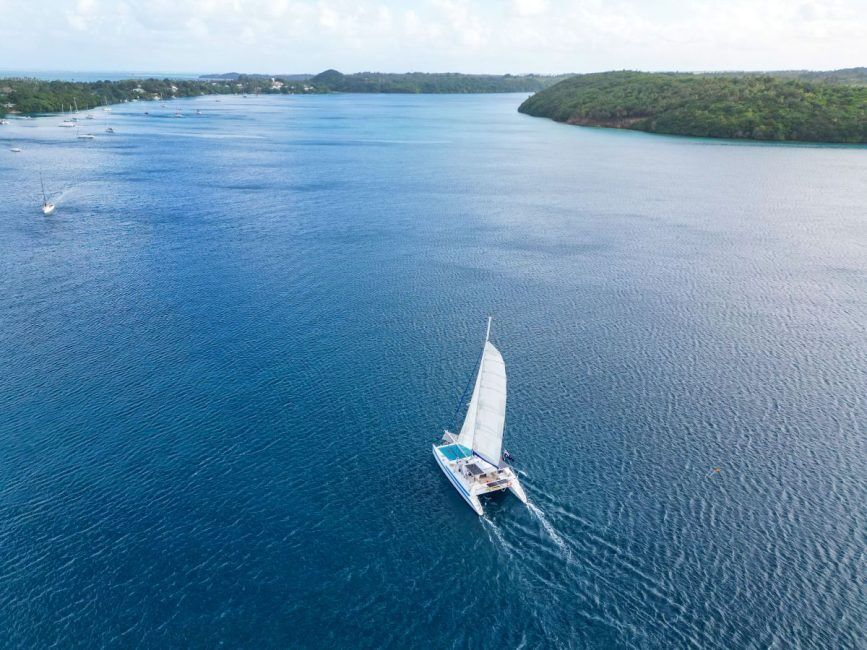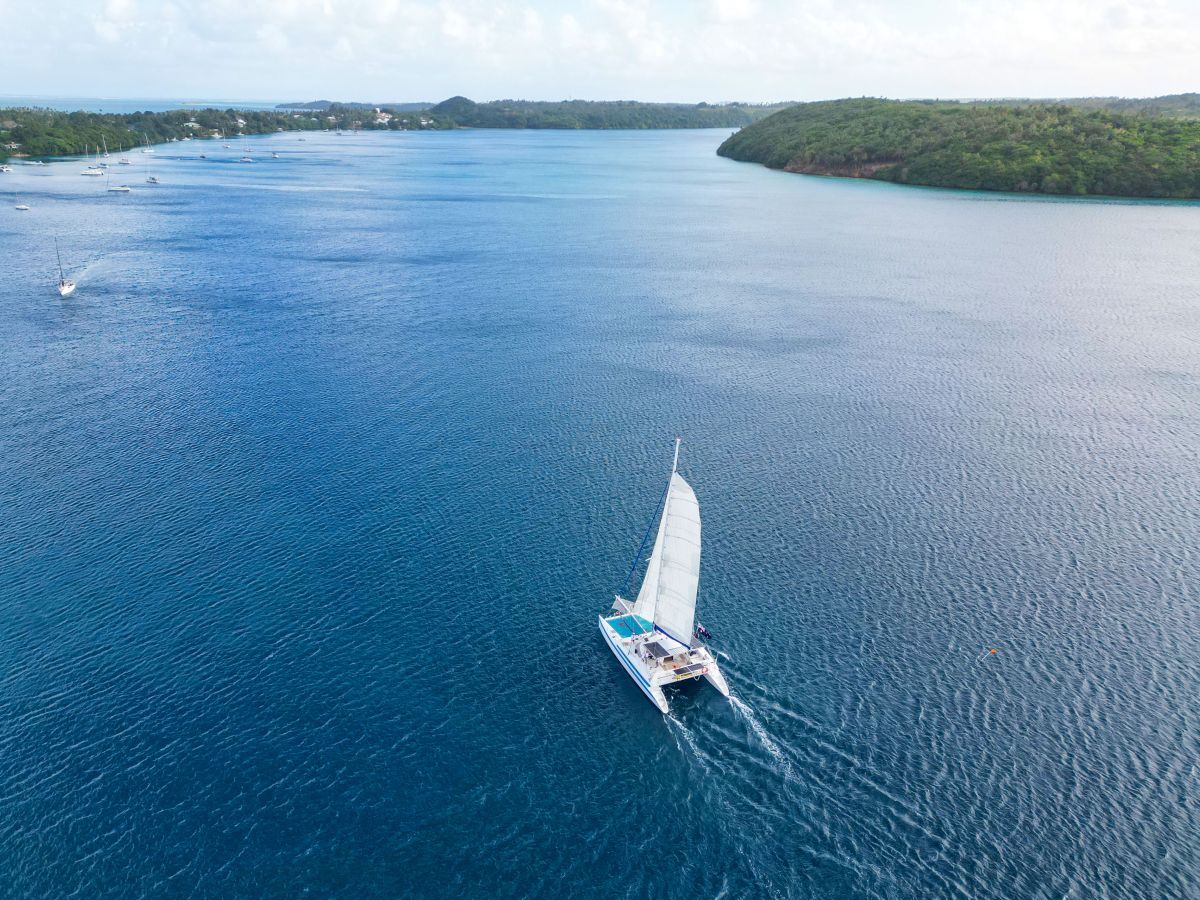What You Need to Know About Sailing in Tonga
Tonga becomes a hub of yacht activity between May and October, where yachts take their Transpacific journey on their way west. The islands are a must on a sailing itinerary, with a maze of inlets to explore in Vava’u, uninhabited (and new) islands to discover in Ha’apai, and remote islands in The Niuas. Even during the cyclone season, yachts haul up in Vava’u’s Port of Refuge which is one of the safest harbours in the South Pacific. So, find out about the regions to visit, the clearance procedures and the essential restriction information in this complete sailing guide to Tonga.
5 Quick Tips for Sailing in Tonga
- You must submit an Advance Notice of Arrival form at least 24 hours before arriving in Tonga
- You cannot go through yacht clearance on a Sunday
- You need to check-in and check-out of each island group in Tonga
- Be aware of the whale interaction restrictions for yachts
- Tonga recognises the maritime VHF Channel 16 for emergencies.
Where to Sail in Tonga
Tonga is an ideal addition to a sailing itinerary in the South Pacific. Typically, Transpacific yachts arrive in Tonga on tradewinds from Samoa, the Cook Islands and French Polynesia, while many others arrive from New Zealand – see How Long Does it Take to Sail to Tonga? Once you’re in Tonga, there are a few amazing sailing grounds worth exploring.
Sailing in Vava’u
The maze of inlets, islands and reefs makes Vava’u, the second-most northern island group in Tonga, the most popular sailing ground in the country – and the South Pacific for that matter. The sheltered waters of the Port of Refuge are a haven for sailors, particularly for mooring in the cyclone season. Vava’u is also well-established with sailing shops and haul-out services at The Boat Yard, while a super yacht agent and generally helpful information for yachties can be found at Cafe Tropicana.
Learn more about Vava’u in The Complete Guide to Vava’u. Plus, check out the Vava’u Port Officer PDF which is packed with essential information for Vava’u and is updated bi-weekly.
Sailing in Ha’apai
The central island group, Ha’apai sits between Tongatapu and Vava’u. The scattering of 62 islands makes for an amazing sailing destination, especially with 45 of the islands being uninhabited. With a complex reef system, Ha’apai requires careful navigation.
Find out more about visiting the Ha’apai islands in The Complete Guide to Ha’apai.
Sailing in The Niuas
For a real adventure, why not sail to Tonga’s most remote islands, The Niuas? Made up of three isolated islands, The Niuas are closer to Samoa than they are to the nearest islands in Tonga, Vava’u. Almost the only visitors that get to experience these islands are yachties.
Discover more about visiting The Niuas in The Complete Guide to The Niuas.
More Islands to Sail to in Tonga
While those are our top picks for island groups to sail to in Tonga, be sure to compare all of your options in The Best Islands to Visit in Tonga.
Clearing Customs for Yachts in Tonga
Tonga Customs requires that all yachts arriving in Tonga from overseas must submit an Advance Notice of Arrival (Small Craft) form at least 24 hours prior to their ETA. This form can be requested and returned to info@customs.gov.to. Yachts that do not submit a form can be fined up to TOP$4,000 and have clearance delayed, withheld or refused.
Ports of Entry in Tonga
The ports of entry in Tonga are as follows:
- Nuku’alofa, Faua Wharf, Tongatapu
- Neiafu, Halaevalu Wharf, Vava’u
- Pangai, Taufa’ahau Wharf, Ha’apai
- Falehau, Niuatoputapu
- Futu, Niuafo’ou.
Yacht Clearance Process
On arrival to any port of entry in Tonga, yachts must fly the yellow Q flag and the captain should contact the Harbour Master or Customs on arrival to be given instructions on where to berth. Give permission for officers from the Departments of Health, Agriculture, Immigration and Customs to board the yacht. Be prepared to present your outward clearance from your last port. Note that there is an approximate TOP$100 health practique fee if you clear in port. This is doubled if you clear out at anchor.
Note that clearance in Tonga usually takes quite some time. It’s best to go through clearance Monday to Friday, during office hours (usually 8:30 am to 4:30 pm, with an hour break around lunch) to avoid overtime fees. Yachts can be cleared on a Saturday at an overtime fee. Yachts cannot be cleared on a Sunday under Tongan law.
Forms that must be submitted to Tonga Customs while in Tonga include (but are not limited to):
- Advance Notice of Arrival (Small Craft)
Must be submitted no less than 24 hours before ETA - Certificate of Clearance (Small Vessels) Form
Must complete on arrival with the Department of Health, Agriculture, Immigration and Customs - Inward Report Form
Submit during your stay. Note that there is a charge if submitted outside of working hours, weekends and public holidays - Outward Report (Small Vessels) Form
Note that there is a charge if submitted outside of working hours, weekends and public holidays - Import Entry (Temporary) Yachts & Small Vessels Form
If you wish to stay up to four months and continue your stay, you must get approval from the CEO of Revenue & Customs - Local Movement Report Form
Required to travel between island groups. The form must be submitted at the island group’s port of entry before travelling within the island group.
Copies of these forms and others can be found on the Tonga Ministry of Revenue & Customs website.
Immigration
Citizens from selected countries get a free 30-day visa upon entry into Tonga or a 90-day visa if from a Schengen member country. Visas can be extended for up to five months through Immigration offices in Nuku’alofa and Neiafu. Find out more about the visitor visa in Do You Need a Visa to Visit Tonga?
Domestic Cruising Check-in/Check-out
You are required to clear in and out of each island group visited in Tonga, known as a domestic check-in/check-out. For this, you will need a Local Movement Report (Small Craft) and check-in/out at customs at each port of entry. If it is not your first or last port in Tonga, you do not need to take the boat to the wharf; you can just visit Immigration and Customs at your convenience (but still within two days). Day sailing within an island group is not restricted.
Again, the Vava’u Port Officer PDF is a helpful document to take you through the yacht clearance and check-in/check-out process for ports across Tonga.
Restrictions for Sailing in Tonga
There are a few restrictions for sailing in Tonga’s waters, from whale swimming to marine reserves. Here are a few restrictions you need to be aware of.
Swimming with Whales
Whales frequent the waters of Tonga every year between June and November. There are strict regulations on whale interactions via non-licensed vessels. It is illegal to swim or kayak with whales unless you are on a licensed boat with a certified guide. You cannot approach the whale any closer than 300 m (330 yards) and jet skis are not allowed within 2 km (1.2 mii) of the whale. Breaking these laws incurs huge fines and could result in visas being cancelled.
Marine Reserves
Like most marine reserves in the world, the marine reserves in Tonga have prohibitions on the collection of shells or marine life.
Marine reserves in Tongatapu include:
- Hakaumamato Reef
- Pangaimotu Reef
- Malinoa Island and Reef
- Ha’atafu Beach
- Monuafe Island and Reef
- Mounu Reef Giant Clam Reserve
- Muihopohoponga Coastal Reserve on Niutoua
Marine reserves in Vava’u include:
- Coral Gardens between Nuapapu and Vaketeitu
- Hunga Lagoon Giant Clam Reserve
- Neiafu Harbour Giant Clam Reserve
- Ano Beach Giant Clam Reserve
Waste Disposal
Throwing rubbish in the waters of Tonga is forbidden. Any rubbish on arrival must be disposed of officially for biosecurity purposes and there will be a fee of approximately TOP$20+ per kg. Visitors need to carry all waste on board and dispose of it in one of the refuse containers in Faua Wharf (Nuku’alofa) or Halaevalu Wharf (Neiafu). Note that there are no recycling facilities in Tonga, so it’s best to take these with you. Used oil and batteries can be dropped off at Cafe Tropicana (Vava’u).
Volcanic Activity
Note that volcanic islands, such as Home Reef and Hunga-Tonga Hunga-Ha’apai, are strictly off-limits if activity has recently been recorded. Vessels must not sail within 5 nautical miles of Tonga’s active volcanoes. On the other hand, it is not a dumb idea to give these islands a wide berth regardless of activity levels…
More About Sailing to Tonga
That’s it for our guide to sailing to Tonga. For more advice on the subject, check out the following:
- The Complete Travel Guide to Tonga
- 31 Tips for Travelling in Tonga
- Tonga Travel Budget: How Much Does a Trip to Tonga Cost?
Finally, for more ways to get to Tonga, take a look at Getting Here: How to Get to Tonga.
Author
Laura (Lola) S.
This article was reviewed and published by Laura, editor in chief and co-founder of Tonga Pocket Guide. Since arriving solo in the South Pacific over 10 years ago with nothing but a backpack and a background in journalism, her mission has been to show the world how easy (and awesome) it is to explore a paradise such as Tonga. She knows the islands inside-out and loves sharing tips on how best to experience Tonga’s must-dos and hidden gems. Laura is also editor of several other South Pacific travel guides.

